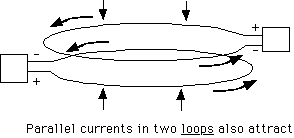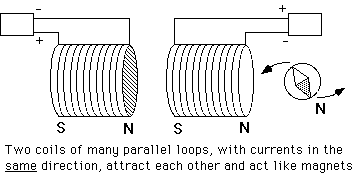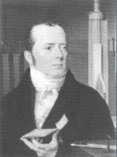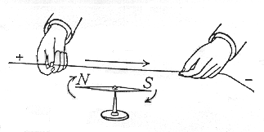 |
| Oersted's Experiment. |
Andre-Marie Ampére in France felt that if a current in a wire exerted a magnetic force on a compass needle, two such wires also should interact magnetically. In a series of ingenious experiments he showed that this interaction was simple and fundamental--parallel (straight) currents attract, anti-parallel currents repel.
The force between two long straight parallel currents was inversely proportional to the distance between them and proportional to the intensity of the current flowing in each.
[Only for those pursuing the math: this is not the basic force formula. Given two short parallel currents I1 and I2, flowing in wire segements of length L2 and L1 and separated by a distance R, the basic formula gives the force between them as proportional to
I1 I2 L1 L2/R2
(it gets further complicated if the currents flow in directions inclined to each other by some angle). To find then the force between wires of complicated shape that carry electrical currents, all these little bitty contributions to the force must be added up. For two straight wires, the final result is as above--a force inversely proportional to R, not to R2]
Here is how this can lead to the notion of magnetic poles.
Bend the wires into circles with constant separation (figure below):
 |
| Parallel currents in two
loops also attract |
Replace each circle with a coil of 10, 100 or more turns, carrying the same current (figure below) and the attraction or repulsion increase by an equal factor. In fact, each coil acts very much like a magnet with magnetic poles at each end (an "electromagnet"). Ampere guessed that each atom of iron contained a circulating current, turning it into a small magnet, and that in an iron magnet all these atomic magnets were lined up in the same direction, allowing their magnetic forces to add up. (Nowadays one could claim that the electrons circling the nucleus carry such a current, but the actual situation is more complicated).

The magnetic property becomes even stronger if a core of iron is placed inside the coils, creating an "electromagnet"; that requires enlisting the help of iron, but is not essential.
 |
| Maxwell
|
Thus two kinds of forces were associated with electricity--electric and magnetic. In 1864 James Clerk Maxwell demonstrated a subtle connection between these two types of force, unexpectedly involving the velocity of light. From this connection sprang the idea that light was an electric phenomenon, the discovery of radio waves, the theory of relativity and a great deal of present-day physics.
Repeat Oersted's Experiment
You will need:
- A pocket compass.
- A one-foot (30 cm) length of fairly thick wire, insulated or bare.
- A 1.5 volt electric cell ("battery") of size "D" or "C". The voltage is too low to cause any risk.
- Lay the compass on a table, face upwards. Wait until it points north.
- Lay the middle of the wire above the compass needle, also in the north-south direction (compare to the above image "What Oersted Saw"). Bend the ends of the wire so that they are close to each other.
- Grab one end of the wire in one hand and press against one end of the battery.
- Grab the other end with your other hand, and press momentarily against the other terminal of the battery. The needle will swing strongly by 90 degrees.
Quickly disconnect (it is not good for the battery to draw such a large current). The needle will swing back to the north-south direction. Note that no iron is involved in producing the magnetic effect!
- Repeat with the connections of the battery reversed. Note that the needle now swings 90 degrees in the opposite direction.
- Take a piece of paper 2"x4" (5x10 centimeters) and fold the longer side into pleats, about 3/8" (1 centimeter) high. Put the wire on the table, its middle in the north south direction, put the pleated paper above it so that the wire is below one of the pleats, and place the compass on top of the pleats. (Or else, use a small block of wood, with a groove cut in its bottom for the wire.)
You can now repeat the experiment with the compass above the wire (if two people perform the experiment, they need no pleats or table--one can old the compass, the other the wire and battery). Note that the needle swings in the opposite direction than when the compass was below the wire.
Next Stop: 9. The Lodestone
Alternative next Stop: 10. Gauss and the Global Magnetic Field
Back to the Master List
| |






